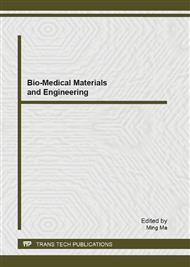p.186
p.192
p.198
p.206
p.211
p.215
p.221
p.228
p.232
Therapeutic Efficacy of Calcium Hydroxide as an Intra Canal Dressing on Postoperative Reaction of Patients with Residual Pulpitis
Abstract:
To evaluate the therapeutic efficacy of calcium hydroxide as an intra canal dressing on controlling postoperative pain and swelling in patients suffering from residual pulpitis. 118 patients with residual pulpitis in their anterior teeth participated in this study. These patients were randomly divided into two groups (group A and group B) of fifty-nine. All teeth were treated with root canal therapy with a two-visit approach. The patients in group A were treated with calcium hydroxide as an intra canal dressing , and in group B using formocresol as an intra canal dressing. All of the patients were followed up for 72 h after each treatment session. The postoperative incidence and severity of pain and swelling were recorded. The data were analyzed by chi-square test and variance analysis. After the first visit, the incidence and severity of pain and swelling showed to be higher in group B and lower in group A. These differences were statistically significant. After the second visit, the incidence and severity of pain and swelling showed to be still higher in group B and lower in group A. But there were no significant difference. Conclusion It is concluded that calcium hydroxide as an intra canal dressing could be effective to decrease the postoperative pain and swelling. It is recommended to use calcium hydroxide as an inter-appointment dressing in teeth with residual pulpitis.
Info:
Periodical:
Pages:
211-214
Citation:
Online since:
August 2013
Authors:
Price:
Сopyright:
© 2013 Trans Tech Publications Ltd. All Rights Reserved
Share:
Citation:


